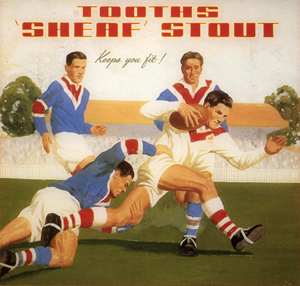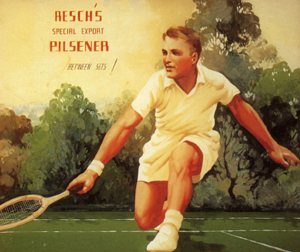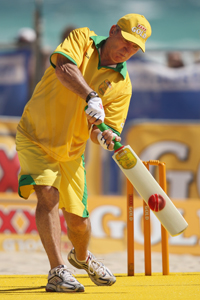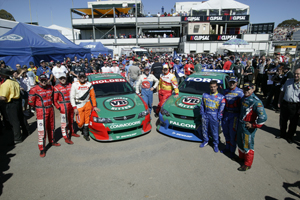
Beer and sport
THERE’S a reason winners of grands prix and grand finals shake up the magnums of champagne at the end of any significant sporting contest.
It’s not because they are happy about winning, because of course they are. Nope, they want to spray as much of that rubbish as they can over everyone around them so they can avoid drinking it.
What they really want is a beer. A beer they can slam down quick, a beer they can share with their team-mates, pit crew or coaching staff.
Champagne is for toasts and canapés and polite conversation. Beer is for celebrating with your buddies, whether you have ground it out on the field or hung on to the edge of your seat in the stands.
In Australia, beer and sport go together like cricket and summer, football and winter, beaches and bikinis, meat pies and tomato sauce. One just would not be the same without the other.
If it wasn’t for beer many of the controversies, the humour, the colour – and let’s not forget the sponsorship money – would be missing from the sporting landscape.
The two together and separately mean a lot to people in Australia. Sometimes devotion to one can lead to trouble in another.
Take the case of former North Queensland Cowboys rugby league player Ian Russell. He loved nothing better than to knock back a VB after a hard game.
The only problem was that the Cowboys were sponsored by XXXX, and the players were required to drink the sponsor’s product when travelling as a team.
Russell was only too well aware of this requirement because he had a suspended $5000 fine hanging over his head from an incident where he was sprung drinking a sly VB.
But after a match against Manly he was on the plane back to Townsville and he just couldn’t resist a can of his favourite brew, and downed a VB in front of team officials and sponsors.
That beer cost Russell $10,000, surely one of the most expensive in history.
Russell’s finances may have taken a massive hit as a result of his love of VB, but that amount of money is small change compared to the millions of dollars spent by beer companies aligning themselves with sport and sports people.
The two big corporations that dominate the beer industry in Australia, Lion Nathan and Fosters, both have eight-figure advertising and sponsorship budgets. Much of that money is directed at sport.
They see great value in sponsoring events and teams, and they often go to war to stamp their name on the nation’s premier contests.
Witness the stoush that broke out between the two majors over sponsor’s rights for the prestigious meetings of Victoria’s Spring racing carnival.
When Lion Nathan muscled in on Fosters’ sponsorship of the Melbourne Cup at the start of the new millennium, it was chequebooks at 10 paces as the two vied with each other to sign up not just racing deals but endorsements in other sports, particularly rugby league.
The intense rivalry persists today and is best seen today in cricket. Fosters is a major sponsor of the Test side and the one-day cricket series. Lion Nathan, not to be outdone, created its own tournament of international beach cricket so they could get the XXXX Gold name in the spotlight.
It was the issue of beer sponsorship that was at the heart of New Zealand losing its right to co-host the 2003 Rugby World Cup, which ended up being run exclusively by Australia.
Heineken was a major backer of the tournament and part of the conditions for hosting the matches was that stadiums be “clean” of advertising and products of the sponsors’ rivals.
One of the sticking points was the pouring rights and signage that local brewers paid big money for to provide beer at certain venues, which Heineken insisted be kyboshed for the duration of the tournament so that its Euro-lager could slake the thirsts of the hundreds of thousands of rugby fans planning to see the games.
The Kiwis failed to guarantee that would happen, and were incredulous and outraged in equal measure when Australia was awarded sole hosting rights. It was a graphic lesson that where sport is concerned, beer money wields a big stick.
Beer companies love sponsorships of sporting events for two reasons: (a) Most beer drinkers are blokes, and most blokes like sport. (b) Sports fans look more kindly upon sponsors than they do straight advertisers. They perceive sponsors as part of the team, as giving something back, and not just trying to separate someone from their money.
Having said that, the beer barons also spend millions on ads that are often clever, sometimes outlandish, but always aired prominently during the television broadcasts of major sporting events. The brewers know that their potential customers will be glued to the tele on match day.
And individual sports stars are often retained as “ambassadors’’ for beer brands. An example is former Test cricketer David Boon, who has a firm association with Cascade, a prominent brewery in his home state of Tasmania.
The linking of beer with sports people and victory is a no-brainer. Having fit, athletic and talented people seen to lap up beer after winning a tough one is so obvious, but so successful as a marketing strategy.
And it has to be said that kicking back with your mates having a few beers and watching sport is one of the great Australian pastimes.
Back in the days when cricket grounds had grassy hills and you were allowed to lie around on them drinking beer out of cans, humour was the inevitable byproduct.
My favourite memory from a cricket match springs from an Ashes Test at the Gabba in the 70s. A Pommy cricket fan who was clearly emboldened by a skinful of XXXX decided to visit the hill with a Union Jack draped around his shoulders.
He instantly became a target, and empty beer cans rained down on him as he ran back and forth in front of the hill like one of those ducks in a shooting gallery.
The brave but foolish Englishman eventually dropped to his knees and covered his head as the metal shower intensified. At that moment a burly Aussie picked up one of the 44-gallon drums used as bins then _ it was full of cans _ and emptied the lot on top of the hapless chap.
To cap it all off, the police moved in and arrested the Pom for inciting the crowd. He was led away with a huge smile on his face and the crowd roaring their approval.
Beer provides moments like that, and moments of madness as it did at Brisbane’s Lang Park during a memorable State of Origin rugby league clash between Queensland’s Maroons and the NSW Blues.
Always tense struggles, the second game of the three-match series in 1988 exploded when referee Mick Stone sent Queensland captain and league legend Wally Lewis to the sin bin.
The parochial Queensland crowd went bonkers, hurling cans of beer onto the field for what seemed like an eternity, trying to hit the ref or anyone in a blue jersey. The NSW players pleaded with Stone to stop the game, but luckily the crowd ran out of missiles before that drastic step was taken.
From that point on beer was never served in cans at major sporting events in Queensland again.
What sport does is give the beer drinker an excuse for sustained consumption. You can build a day around a sporting event which includes mass intake of beer and no one will bat an eyelid in Australian society. But build a day around a mass intake of beer on its own and you’ll be frowned upon.
You could rattle off any number of great sport stories in which beer plays a central part. And without the nexus between beer and sport there would be no streakers, Mexican waves, most sport scandals, large-screen TVs in pubs, long post mortems after the players have gone home, and not nearly as much incentive to actually go to a game.
The reality is that beer is the lifeblood of sport. Not wine, not rum, not Powerade and not cappuccino. Just beer. It’s a winning combination.
Cheers.








